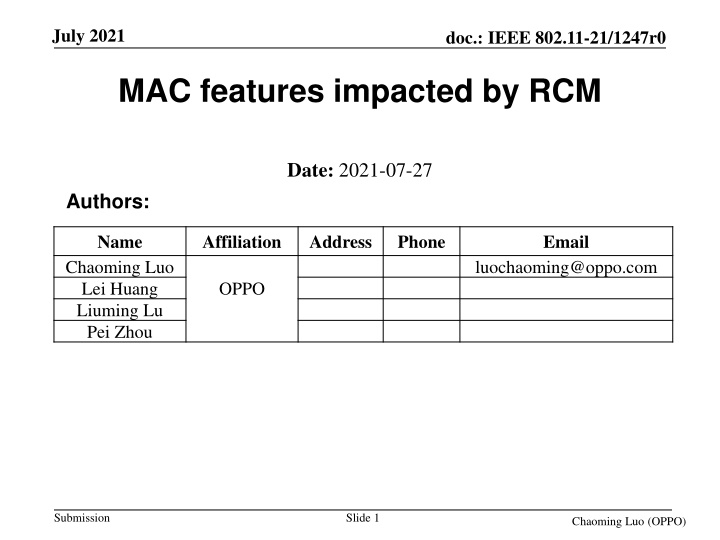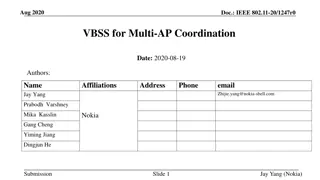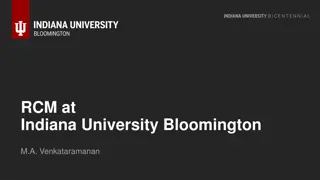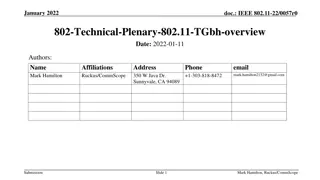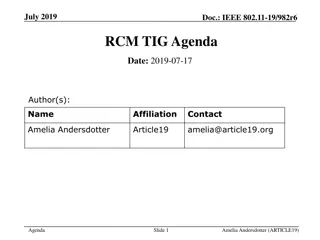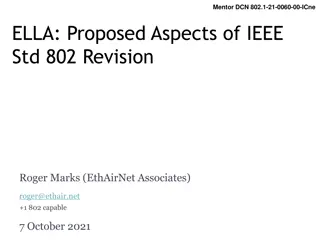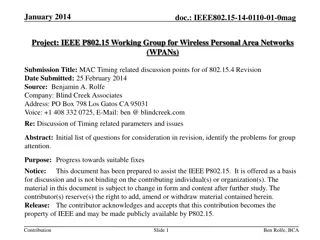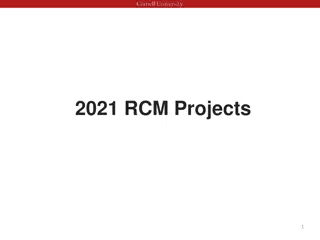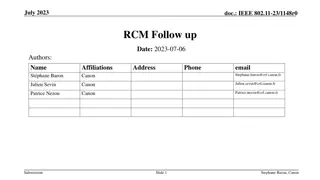IEEE Std. 802.11-21/1247r0 MAC Features Impacted by RCM
This document addresses the impact of random MAC address changes on IEEE Std. 802.11 features such as Pairwise key hierarchy, FT key hierarchy, and FILS authentication. It highlights the need to ensure the validity of provisions referring to a STA's MAC address in IEEE Std. 802.11 when the MAC address is randomized. The content delves into specific key hierarchies and authentication methods affected by these changes.
Download Presentation

Please find below an Image/Link to download the presentation.
The content on the website is provided AS IS for your information and personal use only. It may not be sold, licensed, or shared on other websites without obtaining consent from the author.If you encounter any issues during the download, it is possible that the publisher has removed the file from their server.
You are allowed to download the files provided on this website for personal or commercial use, subject to the condition that they are used lawfully. All files are the property of their respective owners.
The content on the website is provided AS IS for your information and personal use only. It may not be sold, licensed, or shared on other websites without obtaining consent from the author.
E N D
Presentation Transcript
July 2021 doc.: IEEE 802.11-21/1247r0 MAC features impacted by RCM Date: 2021-07-27 Authors: Name Affiliation Address Phone Email Chaoming Luo Lei Huang Liuming Lu Pei Zhou luochaoming@oppo.com OPPO Submission Slide 1 Chaoming Luo (OPPO)
July 2021 doc.: IEEE 802.11-21/1247r0 Introduction As stated in the PAR, many references in IEEE Std 802.11 to MAC address were made at times where the assumption of a unique assocation between a STA and a MAC address was strong. There is a need to ensure that IEEE Std 802.11 provisions that refer to a STA MAC address remain valid when that MAC address is random or changes. [1] This contribution recaps some features in IEEE Std 802.11 that identify a STA by its MAC address, and draws the group s attention to solve the related issue when using random MAC address. Submission Slide 2 Chaoming Luo (OPPO)
July 2021 doc.: IEEE 802.11-21/1247r0 Recap - Pairwise key hierarchy The Pairwise key hierarchy is using the non-AP STA s MAC address. [2] In infrastructure bss, typically: Authenticator MAC address (AA) is AP s MAC address Supplicant s MAC address (SPA) is non-AP STA s MAC address Submission Slide 3 Chaoming Luo (OPPO)
July 2021 doc.: IEEE 802.11-21/1247r0 Recap FT key hierarchy The FT (fast BSS transition) key hierarchy is also using the non-AP STA s MAC address. [2] R0-Key-Data = KDF-Hash-Length(XXKey, FT-R0 , SSIDlength || SSID || MDID || R0KHlength || R0KH-ID || S0KH-ID) PMK-R0 = L(R0-Key-Data, 0, Q) PMK-R0Name-Salt = L(R0-Key-Data, Q, 128) Length = Q + 128 PMKR0Name = Truncate-128(Hash( FT-R0N || PMK-R0Name- Salt)) MDID: the Mobility Domain Identifier field from the Mobile Domain element (MDE) that was used during FT initial mobility domain association R0KH-ID: the identifier of the holder of PMK-R0 in the Authenticator S0KH-ID: the Supplicant s MAC address (SPA) PMKR0Name: used to identify the PMK-R0 Submission Slide 4 Chaoming Luo (OPPO)
July 2021 doc.: IEEE 802.11-21/1247r0 Recap FILS authentication Similarly, when FILS (fast initial link setup) authentication is used, the pairwise keys are also derived by using the non-AP STA s MAC address. [2] FILS-Key-Data = PRF-X(PMK, FILS PTK Derivation ,SPA || AA || SNonce || ANonce [ || DHss ]) ICK = L(FILS-Key-Data, 0, ICK_bits) KEK = L(FILS-Key-Data, ICK_bits, KEK_bits) TK = L(FILS-Key-Data, ICK_bits + KEK_bits, TK_bits) FILS-FT = L(FILS-Key-Data, ICK_bits + KEK_bits + TK_bits, FILS-FT_bits) Submission Slide 5 Chaoming Luo (OPPO)
July 2021 doc.: IEEE 802.11-21/1247r0 Recap Proxy ARP service Again, Proxy ARP service is using the non-AP STA s MAC address too. Clause 4.3.19.13 Proxy ARP: The Proxy ARP service enables an AP to respond to ARP and Neighbor Discovery frames on behalf of associated non-AP STAs. Associated STAs do not receive ARP or IPv6 Neighbor Discovery frames. The Proxy ARP service enables associated STAs to remain in power save for longer periods of time. [2] Clause 11.21.14 Proxy ARP service: When an AP receives an ARP request from one associated STA or from the DS with a target IP address that corresponds to a second associated STA, the AP shall insert the second STA MAC address as the Sender s MAC Address in the ARP response packet. [2] Clause 11.21.14 Proxy ARP service: When an IPv6 address is being resolved, the Proxy ARP service shall respond with a Neighbor Advertisement message (Section 4.4, IETF RFC 4861) on behalf of an associated STA to an Internet Control Message Protocol version 6 (ICMPv6) Neighbor Solicitation message (Section 4.3, IETF RFC 4861). When MAC address mappings change, the AP may send unsolicited Neighbor Advertisement Messages on behalf of a STA. [2] Submission Slide 6 Chaoming Luo (OPPO)
July 2021 doc.: IEEE 802.11-21/1247r0 Proposal Issue: If AP cannot establish the mapping from the MAC address using for association to the ramdomized MAC address after association, the features mentioned could not work properly. Proposal: We should consider a mechanism (e.g., signature method mentioned in 21/1083r0) to assist the AP to identify the non-AP STA when the STA uses a randomized MAC address or changes its MAC address. note: identify the non-AP STA means establish the mapping from the MAC address using for association to the ramdomized MAC address after association . Submission Slide 7 Chaoming Luo (OPPO)
July 2021 doc.: IEEE 802.11-21/1247r0 SP 1 Do you agree that TGbh should consider a mechanism to assist the AP to identify the non-AP STA when the STA uses a randomized MAC address or changes its MAC address. Submission Slide 8 Chaoming Luo (OPPO)
July 2021 doc.: IEEE 802.11-21/1247r0 Reference [1] P802.11bh-par [2] IEEE Std 802.11-2020 Submission Slide 9 Chaoming Luo (OPPO)
